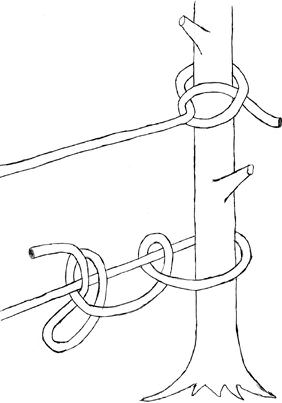

Almost every source that you consult today for basic rope and knot skills, whether in print or online, will list the clove hitch as one of the most important and basic knots for beginners to learn, and most of these sources will show it used in an endline fashion. If you tie a manila rope to a tree with an endline clove hitch, it really does hold quite well, even without the backups. A couple hundred years ago, all ropes had friction built into them because of their materials. I believe this is one of the historical reasons for recommending the clove hitch for use in an endline fashion. Old school manila and hemp ropes have so much more friction to help them grab onto posts and such. The fact that modern ropes are fairly slick also encourages rolling out. But that doesn’t change the fact that it is a midline knot. Easy to learn, easy and quick to tie, easy to inspect visually, easily adjusted, and the list goes on. Why is that? Again, I will fully admit that the clove is without a doubt the best midline hitch available. This very thing has happened over and over again to people in this trade and yet we continue to use and teach this knot. The shock load can literally rip the rope right off the piece, sending it hurling towards the ground in freefall and flinging the end of the rope up into the tree. But who cares how strong it is, if it ends up rolling out? Rolling out occurs when a piece slams into the rigging. See, the problem with the clove hitch in an endline usage is that there is no change of direction, the rope just goes around and around again. Yes, this means that the load is spread out over a lot of rope, resulting in a very strong hitch. Just because it will hold does not mean it is a good choice! We shouldn’t be adding half-hitch backups to our knots and praying that they hold. We are supposed to have a repertoire of highly specialized, bomber knots that just work – period. Let’s be honest here, anybody and their brother can tie half hitches – “if you don’t know knots, tie lots!” We are supposed to be professionals. We need to take more time to select the proper knot instead of using a poorly chosen knot and just throwing half hitches onto it to make sure that it will hold. Tying half hitches should not be the basis of our ropework, especially in critical situations. What is that all about? So you are telling me that this supposedly great knot that pretty much everybody recommends for use in critical rigging scenarios, where knot failure could result in catastrophic property damage or grave injury to any member of the ground crew, requires not just one backup, but in fact, two? Really? I have to be honest here folks, if a knot requires two half hitches to secure it, then you are using the wrong knot! If you want a knot that will really hold, why not just tie 2 half hitches with 2 half hitches! That will hold anything! Seriously, why take the time to tie a clove hitch? See, that is the part to me that is the most interesting and the most problematic: two half hitches. Everyone already knows that the clove hitch can slip, that’s why it is always shown and referred to as a “clove hitch with two half hitches”. So my question is this: why do we continue to use and teach this knot to the younger generation of arborists? I myself have seen it multiple times and have heard many tales. It was never meant to be used in an endline fashion. Anyone doing tree work for long enough has heard stories of a clove hitch rolling out. The clove is meant to have pull from both ends, preferably equal pull. The clove hitch is a midline knot, and when utilized properly, there is none finer. Now before we go any further, I just need to clarify that this is not a universal condemnation of the clove hitch.

It never was. And I will make the argument that we should not be using it or teaching it for rigging purposes. OK, so what am I talking about? Well, despite what we have been told by literally everybody, the fact is, that a clove hitch is NOT an endline knot. Now, I know that what I am about to say is, at least at first, going to seem quite controversial, but I know if you stick with me, we can work through this together and hopefully come out on the other side of it a little better off. Source: World’s Most Versatile Knot? Hmmmm………Īt some point in modern history, and this is not just an arboriculture thing, the lowly clove hitch got a bump in notoriety that was, at least in my opinion, unduly deserved.


 0 kommentar(er)
0 kommentar(er)
